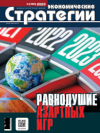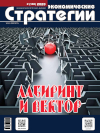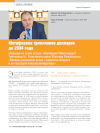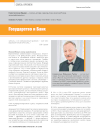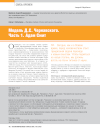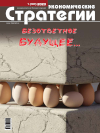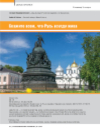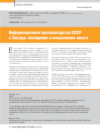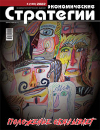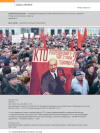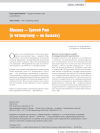How the Fuhrer and Others Like Him Forced out Soviet Oil from the German Market
DOI: 10.33917/es-3.189.2023.118-131
Based on diplomatic documents, a detailed picture of driving oil product suppliers – the Soviet companies, Derop and Derunaft – out from the German market during 1933 is restored. Soviet intelligence materials prove that one of the inspirers of this process can be considered the major Anglo-Dutch oil tycoon Henry Deterding, who in the course of the alleged “crusade” against the USSR, among other things hoped to seize the Caucasian oil fields.
References:
1. Morozov S.V. K voprosu o roli neftyanogo faktora v evropeiskikh mezhdunarodnykh otnosheniyakh v techenie 1933–1935 gg.: VII chteniya, posvyashchennye pamyati R.L. Yavorskogo: Materialy Vserossiiskoi nauchnoi konferentsii s mezhdunarodnym uchastiem[On the question of the role of the oil factor in European international relations during 1933–1935: VII readings dedicated to the memory of R.L. Yavorsky. Materials of the All-Russian Scientific Conference with International Participation]. Novokuznetsk, RIO KuzGPA, 2011, 288 p.
2. Morozov S.V. Khronika vytesneniya sovetskoi nefti s germanskogo rynka v techenie 1933 g.: IX chteniya, posvyashchennye pamyati R.L. Yavorskogo: Materialy Vserossiiskoi (s mezhdunarodnym uchastiem) nauchnoi konferentsii[Chronicle of the displacement of Soviet oil from the German market during 1933: IX readings dedicated to the memory of R.L. Yavorsky. Materials of the All-Russian Scientific Conference with International Participation]. Novokuznetsk, RIO KuzGPA, 2013, 320 p.
3. Gekht E.V. Neft’ v politike Germanii (1933–1943) [Oil in German Politics (1933–1943)]. Avtoref. dis. … kand. ist. nauk. Ekaterinburg, 2007. 22 s.
4. Medlicott W.N. The Economic Blockade. Vol. 1. L., Longmans, Green and Co., 1952, 756 p.
5. Birkenfeld W. Der synthetische Treibstoff 1933–1945: Ein Beitrag zur nationalsozialistischen Wirtschafts- und Rüstungspolitik. Göttingen, Berlin, Frankfurt, Musterschmidt-Verlag, 1964, 278 p.
6. Teichert E. Autarkie und Grossraumwirtschaft in Deutschland 1930–1939: Aussenwirtschaftpolitische Konzeptionen zwischen Wirtschaftskriese und Zwseitem Weltkrieg. München, Oldenburg, 1984, 390 p.
7. Mejcher H. Die Politik und das Öl im Nahen Osten. Bd. 2: Die Teilung der Welt 1938–1950. Stuttgart, Klett-Gotta, 1990, 490 p.
8. Karlsch R., Stockes G.R. Faktor Öl. Die Mineralölwirtschaft in Deutschland 1859–1974. München, C.H. Beck Verlag, 2003, 460 p.
9. Kockel T. Deutsche Ölpolitik 1928–1938. Berlin, Akademie Verlag GmbH, 2005, 393 p.
10. Klein B.H. Germany’s Economic Preparations for War. Cambridge Massachusets, Harvard University press, 1959, 272 p.
11. Friedwald E.M. Oil and the War. L., Heineman, 1941, 88 p.
12. Pеarton M. Oil and the Romanian State. Oxford, Clarendon press, 1971, 361 p.
13. Sesyuli R. IG Farbenindustri[IG Farbenindustri]. Moscow, Gos. izd-vo in-i lit-ry, 1948. 244 s.
14. Bruks M. Neft’ i vneshnyaya politika[Oil and foreign policy]. Moscow, Izd-vo in-i lit-ry, 1949, 173 p.
Biological Crimes — Organic Nature of Nazism
DOI: 10.33917/es-3.189.2023.108-117
Definition of biological weapons is given, periodization of its creation and use is presented. The author draws an analogy between the war crimes aimed at destruction of civilians and war prisoners during the Second W orld War and at the present time. The connection of Nazism and neo-Nazism with biological crimes against humanit y is revealed.
References:
1. Zaitsev A.I. Ostorozhno: biologicheskaya voina [Caution: Biological Warfare]. Zashchita i bezopasnost’, 2020, no 3, pp. 24.
2. Velikaya Otechestvennaya voina 1941–1945 gg.: Dokumenty i materialy, vol. Х. Osvobozhdenie Krasnoi Armiei [The Great Patriotic War of 1941–1945: Documents and materials. T. H. Liberation by the Red Army]. Pod obshch. red. S.K. Shoigu. Moscow, 2017, 463 p.
3. Kontslagerya — zhizn’ v adu [Concentration Camps – Living in Hell]. Alye parusa, 2012, 15 maya, available at: https://nsportal.ru/ap/library/drugoe/2012/05/11/kontslagerya-zhizn-v-adu.
4. Palivoda S. Tragediya i podvig Bukhenval’da [Tragedy and the feat of Buchenwald]. L’vov, Svit, 1990, 285 p.
5. Vakhsman N. Istoriya natsistskikh kontslagerei [History of Nazi Concentration Camps]. Moscow, Tsentrpoligraf, 2019, 877 p.
Biologicheskoe oruzhie i biologicheskii terrorizm. Zashchita ot biologicheskogo oruzhiya voisk, naseleniya i etapov meditsinskoi evakuatsii [Biological Weapons and Biological Terrorism. Protection of Troops, Population and Medical Evacuation Stages Against Biological Weapons]. MED-REF.BY, available
at: https://med-ref.by/referati_mes/2729-referat-biologicheskoe-oruzhie-i-biologicheskiy-terrorizm-zaschita-ot-biologicheskogo-oruzhiya-voysk-naseleniyai-etapov-medicinskoy-evakuacii.html.
V Rossii zayavili o nachale biologicheskoi voiny [In Russia the beginning of Biological Warfare was Announced]. Dzen, 2020, 2 maya, available at: https://dzen.ru/a/Xq1TC2jzBlqJIiU6.
Geneticheskoe oruzhie [Genetic Weapons]. Akademiya Alekseeva, available at: https://aleksejev.ru/free_portfolio/1252/22393/?p=3.
Konventsiya o zapreshchenii razrabotki, proizvodstva i nakopleniya zapasov bakteriologicheskogo (biologicheskogo) i toksinnogo oruzhiya i ob ikh unichtozhenii [Convention on the Prohibition of the Development, Production and Stockpiling of Bacteriological (Biological) and Toxin Weapons and on
their Destruction]. Ofitsial’nyi sait OON, 1971, 16 dekabrya, available at: https://www.un.org/ru/documents/decl_conv/conventions/bacweap.shtml.
Konovalov P.P., Arsent’ev O.V., Buyanov A.L., Nizovtseva S.A., Maslyakov V.V. Primenenie biologicheskogo oruzhiya: istoriya i sovremennost’ [Use of Biological Weapons: the History and the Present]. Sovremennye problemy nauki i obrazovaniya, 2014, no 6, p. 1170.
Supotnitskii M.V. Zhivaya smert’: chto takoe biologicheskoe oruzhie [Living Death: what is a Biological Weapon]. Populyarnaya mekhanika, 2018, no 1, pp. 74–77.
Tan U. Khimicheskoe i bakteriologicheskoe (biologicheskoe) oruzhie i posledstviya ego vozmozhnogo primeneniya: Doklad na XXIV sessii General’noi Assamblei OON [Chemical and Bacteriological (Biological) Weapons and the Consequences of Their Possible Use: Report to the XXIV Session of the UN
Trillion Dollar Metaphysics until 2034
State and Bank
D.S. Chernavsky Model. Part 1. Adam Smith
DOI: 10.33917/es-2.188.2023.98-107
This article considers the system of views of D.S. Chernavsky on the economics of Adam Smith. It turns out that the famous English economist was a convinced statesman. In his famous work “On the Nature and Causes of the Wealth of Nations” he substantiates the need for price regulation, limiting interest rates and also considers transnational corporations the greatest evil in the economy (he calls them “large joint-stock companies”). A. Smith convincingly proves that money is a tool for generating income, but not the income of society itself.
The appendix to the article presents a mathematical model of the loan capital functioning, developed by the author under the guidance of D.S. Chernavsky.
References:
1. Shcherbakov A.V. Mifologiya Adama Smita (o chem na samom dele kniga “Issledovanie o prirode i prichinakh bogatstva narodov”) [Mythology of Adam Smith (what “An Inquiry into the Nature and Causes of the Wealth of Nations” is Actually about)]. Moscow, Grifon, 2016, 64 p.
2. Smit A. Issledovanie o prirode i prichinakh bogatstva narodov [An Inquiry into the Nature and Causes of the Wealth of Nations]. Moscow, Eksmo, 2007.
3. Marks K., Engel’s F. Manifest Kommunisticheskoi partii: Sochineniya [The “Manifesto of the Communist Party”: Essays]. Vol. 4. Moscow, Gosudarstvennoe izdatel’stvo politicheskoi literatury, 1955, 616 p.
4. Chernavskii D.S., Shcherbakov A.V. Mir bez dollara i FRS [World without the Dollar and the Fed]. Institut sotsial’no-ekonomicheskogo prognozirovaniya im. D.I. Mendeleeva, available at: http://mendeleev-center.ru/articles/article-0006.html.
5. Polnyi spisok vsekh voennykh prestuplenii SShA [Complete list of all US war Crimes]. Oko planet, 2011, 16 iyunya, available at: http://oko-planet.su/politik/politiklist/71678-polnyy-spisok-vseh-voennyh-prestupleniy-soedinennyh-shtatov-ameriki.html.
6. Sorok protsentov mirovogo bogatstva kontroliruyut 147 transnatsional’nykh korporatsii [Forty Percent of the World’s Wealth is Controlled by 147 Multinational Corporations]. Gumanitarnyi portal, 2011, 24 oktyabrya, available at: https://gtmarket.ru/news/corporate/2011/10/24/3685.
Tell Everyone that Rus’ is Always Alive
DOI: 10.33917/es-1.187.2023.110-119
The fate of Russia is a hard military work, wars with various defensive and offensive goals. The people at war, their heroism and tragedy – this is the leitmotif of this article. History of the Fatherland is essentially a military chronicle of Russian statehood. It is important to feel the inextricable thread of times, the full depth and richness of the Fatherland’s heroic traditions, dating back to ancient times.
Information Warfare of the USSR and the West: Generalization and Experience Comprehension
DOI: 10.33917/es-1.187.2023.98-109
The article presents a factual retrospective review of the public consciousness deformation as a result of successful subversive
ideological and psychological work against the USSR, carried out by the United States in the second half of the 20th century, called the Cold War. Evidence from documents and memoirs of the events participants allows us to realize the continuing relevance of the systemic danger of a destructive information impact for modern Russia.
References:
1. Klain R. TsRU ot Ruzvel’ta do Reigana [CIA from Roosevelt to Reagan]. New York, 1988, p. 166.
2. Lainbardzher P. Psikhologicheskaya voina. Teoriya i praktika obrabotki massovogo soznaniya [Psychological Warfare. Theory and Practice of Processing Mass Consciousness]. Moscow, 2013, pp. 98–120, 121–164.
3. Pechataetsya po izd.: SShA: ekonomika, politika, ideologiya, 1989, no 12, per. G.V. Zdornykh.
4. Etzold T.H., Gaddis J.L. Containment: Documents on American Policy and Strategy, 1945-1950, NSC 20/1 (pages 173-203) // Direktiva SNB SShA 20/1 ot 18 avgusta 1948 g.
5. Khinshtein A. Kak ubivayut Rossiyu [How They Kill Russia]. Moscow, Abris, OLMA, 2018, 448 p.
6. Khlobustov O.M. KGB SSSR 1954–1991. Tainy gibeli Velikoi derzhavy [KGB of the USSR 1954-1991. Secrets of the Death of the Great Power]. Moscow, 2013, pp. 73.
7. Khlobustov O.M. Eshche raz o «preslovutom plane Dallesa» [Once Again About the “Notorious Plan of Dulles”]. Trudy Obshchestva izucheniya istorii otechestvennykh spetssluzhb. T. I. Moscow, 2006, pp. 221–220.
8. Shveitser M. POBEDA [Victory]. Minsk, 1995, pp. 77.
9. Anan’ev A.A. Prizvanie Ryurikovichei, ili Tysyacheletnyaya zagadka Rossii [Vocation of the Rurik Dynasty or the Millennium Mystery of Russia]. Moscow, 1996, p. 304.
10. Zhdanov A.A. O mezhdunarodnom polozhenii: Doklad na I soveshchanii Kommunisticheskogo informbyuro 25 sentyabrya 1947 g. [On the International Situation: Report at the 1st Meeting of the Communist Information Bureau on September 25, 1947.]. Rossiiskaya gosudarstvennaya biblioteka, available at: https://search.rsl.ru/ru/record/01005794410
11. Glavnyi protivnik: Dokumenty amerikanskoi vneshnei politiki i strategii 1945–1950 gg. [The Chief Enemy: Documents of American Foreign Policy and Strategy 1945–1950.] Moscow, 2006.
12. Pocheptsov G. Informatsionnye voiny. Osnovy voenno-kommunikativnykh issledovanii [Information Wars. Fundamentals of Military Communication Studies]. Elektronnaya biblioteka RuLit, available at: https://www.rulit.me/books/informacionnye-vojny-osnovy-voenno-kommunikativnyh-issledovanij-read-350904-1.html
13. Khlobustov O.M. Fenomen Andropova: lichnost’ i ee rol’ v istorii / Istoricheskie chteniya na ul. Andropova, 5. Istoriya organov bezopasnosti: materialy VI mezhdunarodnoi nauchnoi konferentsii, posvyashchennoi 70-letiyu Pobedy sovetskogo naroda v Velikoi Otechestvennoi voine 1941–1945 gg. [The Andropov Phenomenon: Personality and its Role in History / Historical Readings on the Andropova street, 5. History of Security Agencies: Materials of the VI International Scientific Conference Dedicated to the 70th Anniversary of the Victory of the Soviet People in the Great Patriotic War of 1941–1945.]. Petrozavodsk, 2016. S. 257.
The USSR Collapse in the Light of Fractal Cyclical Nature of the Russian History
DOI: https://doi.org/10.33917/es-5.185.2022.114-119
The article proposes an approach to the problem of the USSR collapse within the framework of interdisciplinary direction of megahistory and global evolution, where the USSR collapse itself turned up to be a bifurcation of the scale invariance of the producing economy history. Its final world cycle gives a picture of periods that completely coincides with the written history of Ancient Russia — the Russian Empire — the USSR.
References:
1. Kuzyk B.N., Ageev A.I., Dobrocheev O.V., Kuroedov B.V., Myasoedov B.A. Rossiya v prostranstve i vremeni (istoriya budushchego) [Russia in Space and Time (History of the Future)]. Moscow, INES, 2004, 336 p.
2. Kul’pin E.S. Geneticheskie kody tsivilizatsii. Sotsioestestvennaya istoriya. Genezis krizisov prirody i obshchestva v Rossii [Genetic Codes of Civilizations. Socionatural History. Genesis of Crises of Nature and Society in Russia]. Vyp. 4. Moscow, Moskovskii litsei, 1995, pp. 32–35.
3. Kul’pin E.S. Sotsioestestvennaya istoriya. Ot metoda — k teorii, ot teorii — k praktike [Socionatural History. From Method to Theory, From Theory to Practice]. Volgograd, Uchitel’, 2014.
4. Gridchin I.V. Sotsioestestvennaya istoriya kak megatsikl istorii chelovechestva [Socionatural History as a Megacycle of Human History]. Istoriya i sovremennost’, 2017, no 1, pp. 177–183.
5. Gridchin I.V. Troichnyi ritm faz sotsial’noi megaistorii. Ego prikladnoe znachenie dlya sistemnogo analiza i prognozirovaniya. Evolyutsiya. Patterny evolyutsii [The Ternary Rhythm of the Phases of Social Megahistory. Its Applied Significance for System Analysis and Forecasting. Evolution. Evolution Patterns]. Volgograd, Uchitel’, 2018, pp. 139–156.
6. Kul’pin E.S. Zolotaya Orda: sud’by pokolenii [Golden Horde: Destinies of Generations]. Vyp. XXVIII. Moscow, INSAN, 2006. (Seriya: Sotsioestestvennaya istoriya. Genezis krizisov prirody i obshchestva v Rossii.)
7. Bzhezinskii Z. Soedinennye Shtaty prevyshe vsego. Mezhdunarodnye posledstviya 1989 goda [The United States Above All. International Consequences of 1989]. Nezavisimaya gazeta, 1999, November 24.
8. Bulkin V.A., Dubov I.V., Lebedev G.S. Arkheologicheskie pamyatniki Drevnei Rusi IX–XI vekov [Archaeological Sites of Ancient Russia of the 9th–11th Centuries]. Leningrad, LGU, 1978.
9. Gridchin I.V. Raspad SSSR [Collapse of the USSR]. Priroda i chelovek. XXI vek, 2017, no 4, pp. 19–22.
10. Slavkina M.V. Triumf i tragediya. Razvitie neftegazovogo kompleksa SSSR v 1960–1980-e gody [Triumph and Tragedy. Development of the Oil and Gas Complex of the USSR in the 1960s–1980s]. Moscow, MAKS-Press, 2002.
Moscow — Third Rome (and the Fourth do not Happen)
DOI: https://doi.org/10.33917/es-5.185.2022.107-113
The talk of “vision of the future” that has been going on in recent years actually ignores the fact that in our history this problem has been solved. Having proclaimed: “Moscow is the Third Rome,” Elder Philotheus did not simply formulate an ideologeme, due to the necessity of that time. He expressed the idea of our statehood, which developed from the very beginning of its formation and determined the movement of our country.
References:
1. Kulikov D.E., Sergeitsev T.N. Ideologiya russkoi gosudarstvennosti [The Ideology of Russian Statehood]. Saint Petersburg, Piter, 2020.
2. Bogdanov A.A. Tektologiya [Tectology]. Moscow, Finansy, 2003.
3. Bogdanov A.A. Nauka ob obshchestvennom soznanii: Poznanie s istoricheskoi tochki zreniya (Izbrannye psikhologicheskie trudy) [The Science of Social Consciousness: Knowledge from a Historical Point of View (Selected Psychological Works)]. Moscow, Moskovskii sotsial’no-psikhologicheskii institut, 1999.
4. Khaidegger M. Nauka i osmyslenie: Bytie i vremya [Science and Understanding: Being and Time]. Moscow, Respublika, 1993.
5. Gumilev L.N. Drevnyaya Rus’ i Velikaya step’ [Ancient Russia and the Great Steppe]. Moscow, Astrel’, 2012.
6. Khaidegger M. Vopros o tekhnike: Bytie i vremya [The Question of Technology: Being and Time]. M.: Respublika, 1993.
7. Gumilev L.N. Ot Rusi do Rossii [From Rus to Russia]. Moscow, Airis-Press, 2001.
8. Stalin I.V. Ekonomicheskie problemy sotsializma v SSSR [Economic problems of socialism in the USSR]. Moscow, Gospolitizdat, 1952.
9. Pyzhikov A.V. Grani russkogo raskola [Facets of the Russian Split]. Moscow, Drevlekhranilishche, 2013.
10. Fromm E. Imet’ ili byt’ [To Have or to Be]. Moscow, AST, 2016.


